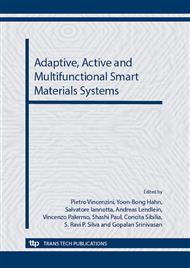p.196
p.205
p.209
p.215
p.220
p.225
p.231
p.237
p.246
Magnetic Properties of the Bi7Fe3Ti3O21 Aurivillius Phase Doped with Samarium
Abstract:
Bismuth layer-structured compounds in the Bi-Ti-Fe-O system known as Aurivillius phases are single phase multiferroics. It was stated that substitution of some rare earth elements for bismuth ions in such structure can modified its magnetic properties. Powders of Bi7Fe3Ti3O21 and Bi6.3Sm0.7Fe3Ti3O21 were prepared by co-precipitation – calcination method and then were sintered to dense polycrystalline materials. Low field DC susceptibility was measured in the zero field cooled (ZFC) and field cooled (FC) modes at 10÷350 K. For selected temperatures magnetisation curves and hysteresis loops were also measured. The FC and ZFC curves of both samples diverge at temperatures below 250 K indicating a spin glass-like behaviour. The compound with samarium exhibits magnetic hysteresis already at room temperature with the coercive field increasing to 870 Oe at 10 K. The low temperature hysteresis loops of the samarium containing compound are shift with respect to zero field which can be attributed to a magneto-electrical coupling of the samarium sublattice "exchange biased" by the iron one, which orders anti-ferromagnetically at a higher temperature than the samarium sublattice.
Info:
Periodical:
Pages:
220-224
Citation:
Online since:
September 2012
Keywords:
Price:
Сopyright:
© 2013 Trans Tech Publications Ltd. All Rights Reserved
Share:
Citation:


